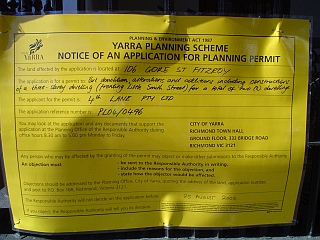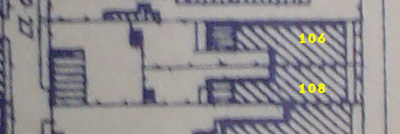Preserving Gore Core
A day after returning from Manila we discovered that the proposed development at the rear of Gore Core is now being applied for and will most likely see no less than three floors erected!

The rear of 106 Gore Street may have heritage value given the discovery of an asphalt pan, one metre below the surface. There has been discussion, of an anecdotal nature, that there could be a connection between the original use of this area that co-joined 108 Gore Street and the tunnels beneath Smith St.
Investigation of early drainage maps point to a structure built across the rear of both properties and “gravel” that is said to have been the location of a livery stables where horses and carriages were stored and/or hired from.

As you can see from this drainage map (date unknown) the two properties were once co-joined at the rear where a structure had existed. It is also marked as “gravel” indicating it's possible use as a livery.

On this cable tram infrastructure map (date unknown) the structure at the rear of 106-108 is more clearly defined. Further investigation of its use and heritage value is continuing.
The rear of 106 contains one of the few remaining gardens of its size in this area of Fitzroy. Not only is it home to an eighty-year-old ‘manna’ gum tree, but also the bird life it supports is essential to maintaining and sustaining the diminishing eco-systems in the Melbourne CBD.
Should there be any thought to remove the tree at the rear of Gore Core, Alex Thomas, from Didg Information Systems, listed the following:
- the tree is very likely to be relatively rare within the local landscape (although I don't really know)
- the tree is in a rare age class, where it is naturally forming hollows in its limbs
- the tree is not replaceable through the presence of other surrounding trees because most of the surrounding trees are non-native
- the tree is somewhat protected because it is not on public land
- this tree produces an accessible nectar that is the principal food of native bird species, whereas surrounding non-native trees do not
- this tree is a specific hollow-forming species
- replacing the nesting services the tree currently provides may be relatively expensive
- this tree is actively providing breeding places for birds and probably reptiles
- this tree is probably one of the few natural sources of seed and pollen native to the area
- relatively speaking it's a substantial perch for birds to make breeding and territorial song from
- relatively speaking it is a safe ecological refuge in a sea of hostile urban fauna and habitat
- we can estimate how many tonnes of greenhouse gasses it's loss would release into the atmosphere
- it provides a cooling amenity through it's canopy shade which if removed will incur costs to replicate
- its removal will possibly destabilise the ground and damage surrounding buildings
- removing it will be a big job with significant liability and damage insurance issues
- making it a feature of a redevelopment could be a market differentiator
Needless to say, Justina and I are both distressed at the prospect of having to move again. Losing the garden is one thing, losing rear access to the premises means we would be locked in as there is no possible way of removing our furniture from the lower-ground floor without it.
National Trust reference: 106-108 Gore Street, State Library archive photo
Justina's additional objections.
compositions
gallery
journal
press
projects
sound
stills
text
video
+ Garton's PODCAST
+ Garton's MySpace
+ secession records
SPAA Fringe & CBAA
myspace video
On being an adult
OPEN CHANNEL 21C
Graz Radio Helsinki
Something on the other side
[madebeer1] has left
a week in words
the patton
from old new
Public domain drain
Interview: Australia, where technology plays the role of spoilsport
Punk Commons
Road to Rio
Toy Satellite/Secession
PO Box 1681
Collingwood, 3066, Australia
Tel/Fax: +61 (0) 3 9318 1222
ag @ toysatellite.org
